When it comes to video games these days, it’s easy to get lost in a story that’s right in front of your face. Sure there’s world-building and histories but one series that truly knows how to immerse the player into a realm created solely upon lore is Dark Souls and Bloodborne. A story is great when it’s easy to see and understand, but if you’re like us and poured hours into reading item descriptions in-game, staring at wiki’s, and spending your hard-earned cash on the Dark Souls Compendium (totally worth it by the way and here’s to hoping for a Bloodborne edition), then you’ll know it’s as satisfying as beating a particular boss whilst throwing your controller and roaring a victory cry. With literal tears, I might add.
The very mention of From Software games summons a variety of reactions, many of them surrounding the fact that these games are not necessarily beginner-friendly. But in this year of our Dark Lord, 2019, ‘gitting gud’ is no longer the barrier it used to be. Beyond the difficulty lies an unequaled sense of accomplishment, and some of the finest storytelling in contemporary gaming. This is why we, Jorge and Milan shall engage in jolly cooperation to celebrate the stories that work in tandem to make the SoulsBorne games such a unique experience.
Discussion is encouraged and if you feel we should have included a particular bit that you feel should be here, please tell us in the comments. We could talk about this for days! I’m being literal, don’t tempt us.
- The Hunters Nightmare
“A hunter who goes drunk with blood is said to be taken by the Nightmare, destined to wander forever, engaged in an endless hunt. It is a fate that no Hunter can escape”
- Eye of a Blood Drunk Hunter
Now imagine a place where you do what you love, what you feel is your very purpose, only over and over again. An uncontrollable urge to hunt and kill, drunk off the blood of a hunt for all eternity. For Hunters in Bloodborne this must seem like a paradise, but is it really? The Old Hunters DLC features this twisted reality where the world is tailored for those who can no longer control their primal need to kill. the implications of certain figures we see there give us quite the case in character study on who they truly were. While we’ll speak of the later two occupants another time, for me seeing both Ludwig and Laurence here spoke volumes of what truly became of the schism of Byrgenwerth.
It seems that in the end Laurence did not follow Willem’s old adage; considering his inclusion as not only a creature in the Hunters nightmare, but also a very lamenting boss. What I find most interesting is whether he is here because of his founding of the healing church or did his disrespect for the old blood cause a ripple in all the members of the healing church? An example of that being the curse of the house of Atreus featured in Homer’s epics. Or did his part in the slaughter of the Fishing Hamlet earn him a place here? He may not have ended the life of Kos but surely his order did.
Whichever the case, an ocean of bloodstains their hands through the deeds of the Healing Church and the Workshop. Such legacy is sure to reshape them, especially in a nightmare where the past comes back to life, directly shaped by history. Thus we get Ludwig the Accursed, who stands out from the rest of the Beasts. This is because of the Holy Moonlight Sword in his possession, perhaps associated with the Moon Presence by the item’s description. His sword grants him perilous clarity during his boss fight, and also afterwards, when his true nature comes to light. Ludwig’s purpose was always to fight the scourge of beasthood, unknowing of the inner corruption that festered in the Healing Church.
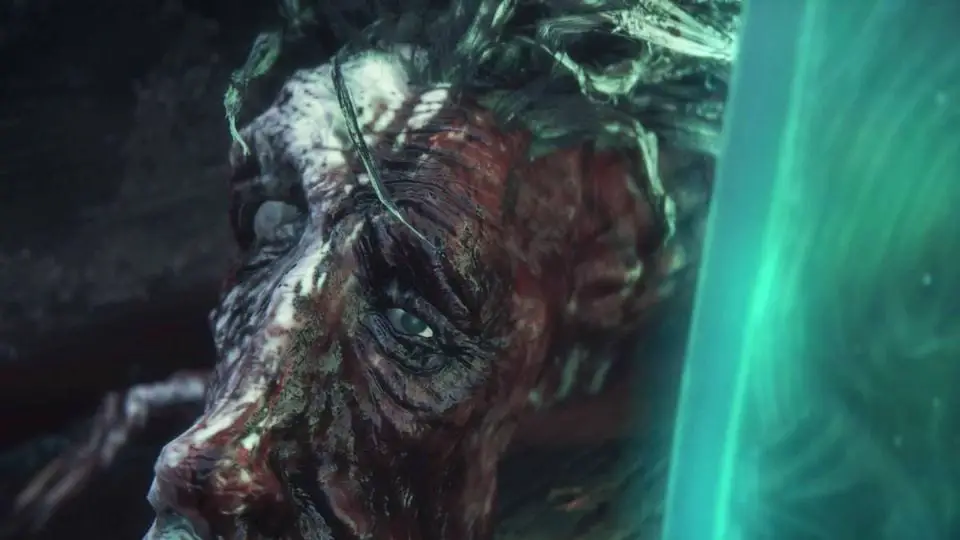
As for the founder of the Healing Church proper, Laurence’s appearance here strikes a more familiar note with the rest of the game. He is literally a Cleric Beast with a dash of fire. But one has to notice that he no longer seems to retain even a morsel of rational thought. In an ironic turn, his breakout from Byrgenwerth has landed him a gulf away from his original purpose to seek knowledge in the Old Blood. Now, he’s little more than a beast running on sheer primal instinct. The ravenous search for knowledge has metabolised into ravenous bloodshed en masse. One may harbour doubts on Ludwig, but Laurence’s fate seems somewhat more fitting, pathetic, and maybe even deserved.
- Solaire of Astora
“I will stay behind, to gaze at the sun. The sun is a wondrous body. Like a magnificent father! If only I could be so grossly incandescent!
- Solaire of Astora
Of course, the mascot of the series and overall lovable NPC that is Solaire would make it on to this list, I mean how could he not? For one he represents everything we are as players. Determined, willing, and drawn by the prospects of where our road will lead us. Compared to every other NPC the series has to offer he is the seemingly simple and normal, yet when it comes to uniqueness, there’s no shortage of it. Neither is there any shortage of his jolly cooperation. He also acts as a guide of sorts, letting us know early on that time is distorted in this land, giving us an explanation as to why so many specters of the past are still around, including bosses.
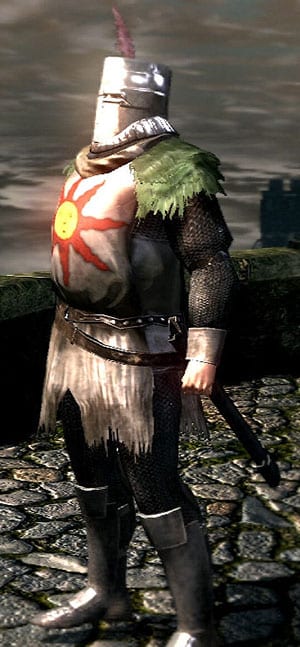
Solaire, an undead like us, is on a journey to find his very own sun. It was speculated that he was Gywn’s firstborn who we learned was erased from memory for some heinous crime. However, both by realizing that Solaire is human and the Nameless King’s lore in Dark Souls 3 it is obvious he is not. Thus his “very own” sun remains a mystery to this day. Some say that he was looking for Gywn so that he may link the fire and that the sun was the Lord Soul. Others think we might have been his sun all along and that he was looking for our soul. The possibilities are endless really.
He also serves as a plot device for a legacy that lasts for all three games. From him, we first hear about the Warriors of Sunlight covenant, one of the many multiplayer covenants that act as player communities. In this case, it works like the character himself. An eagerness to help those struggling with the game will always find allies among the Warriors of Sunlight. While it does cost a lot to save him from losing his sanity via the sunlight maggot, it’s worth every humanity as killing him is literally the most painful thing ever.
- The Reign and Legacy of Gravelord Nito
“We are Milfanito. We are here to sing to those bound by death and Dark.”
- Milfanito
Civilization in the Dark Souls mythos began with the defeat of the Dragons in the times before Disparity (light and dark, life and death), and the ensuing Age of Fire. Each of the Lords had their role in this ascension. Gwyn built the kingdom, Izalith attempted (and disastrously failed) to ignite a new Flame, and the Furtive Pygmy sired humanity. Their actions all deliberately extend outwards into the uncertain future of this world. But Nito, the Lord of Death, seems an island of his own. His deeds for the Age of Fire practically ended when delivering the killing blow to the Dragons. He is an obscure figure in Dark Souls. His domain is one of the least liked in the game. But these reasons are an unlikely invitation to give him a longer, more detailed look on our own.
So let’s start with his chief drive. All Nito really wants is to spread death. He may even recruit you into fulfilling this through his Covenant. It’s a one-dimensional motive, but it has interesting ramifications when you consider his likely offspring: the Milfanito and the Fenito from Dark Souls II, beings devoted to protecting and soothing those bearing death and darkness. This obviously means the Dead and the Undead, but don’t the latter remind you of something? Humans will inevitably fall within this mantle via the Undead Curse. While the rest of the world may shun you, Nito’s realm shall (in theory) welcome you. The Gravelord looks somewhat more benign when considering he indirectly provided means for Vendrick to guard his soul against Nashandra in the Shrine of Amana through the Milfanito keeping her at bay.
Back on the uglier side of things, Nito’s realm has a peculiar connection with the Way of White. The folk in white mercilessly hunt the Undead, but when falling to the Curse themselves, they get a new duty. Pilgrimage into Nito’s domains, in search for the Rite of Kindling. The Gravelord used to own this power, which could strengthen bonfires using Humanity. However, a necromancer stole this power in hopes of bringing his family back to life. He failed and became Pinwheel instead, who we vanquished and took the Rite from. Perhaps, this theft is the reason we could defeat Nito at all.
Amusingly, the pilgrimages may not have stopped after we got the Rite. So the Way of White may continue on a wild goose chase in the dark. However, Nito may be ironically in the dark himself about his role in the cycle. Gwyn ultimately wants death to spread, so the Undead will burn Humanity at the bonfires, just to maintain the Age of Fire a little longer. This inevitably leads to the Chosen Undead going against Nito and defeating him. And, depending on your choice, a new Age of Fire may not actually follow. But whether you choose to rekindle the flame or not, Nito’s legacy will always remain. Death.
- The Ivory King and the Silent Oracle
“My dear lord, a most true king. It was with his magnificent soul that he built Eleum Loyce…and contained the spread of Chaos. But the Chaos would not be sated, and the King gave his own soul.“
- Alsanna, The Silent Oracle
Sometimes, you just want a love story; sex sells, but so do feels. As previously stated, Nashandra is not what she appeared to be. Her look as the final boss is a dead giveaway, but a further look into certain item descriptions reveal her as a fragment of Manus, Father of the Abyss, whom we vanquished in the DS DLC. That’s why it’s in her nature to covet power, that is, the Throne of Want. However, she did not emerge alone from the dark. Elana, Nadalia, and Alsanna were her sisters, all Queens in different, respective lands. All followed the want for power. But in Alsanna’s case, the pursuit led her somewhere unexpected.
Soon, she became Queen to the Ivory King, a knight who held authority by prowess and bravery. This would have signified the power for Alsanna, the Silent Oracle to feast upon, if not for an unforeseen event. When the Old Chaos (borne from Izalith’s attempt to recreate the First Flame) began to stir in the northern lands of Eleum Loyce, the Ivory King stepped forward to be the first line of defence against the Chaos beneath the city. Naturally, he took his Queen along for the ride. Not only did she exhibit great powers of her own, the Ivory King genuinely loved Alsanna. All this, despite full awareness of her true nature. He believed her to be a better person than the make of her being, and she proved him right, as her future deeds would far distance her from her sisters.
Eventually, the Ivory King felt his own soul decaying. Whether this was from Alsanna’s presence, or from the Chaos’ stirring below the city is uncertain. But rather than run from the Chaos, he cast himself into it hoping to appease it. Essentially, a suicide mission. Alsanna, having inherited this Kingdom, decided to isolate it and stay vigilant over the Old Chaos. And so, the lonely Queen waits behind the veil of ice for a strong warrior to lend their might, and free her husband. More than a bittersweet love story, the saga of the Ivory King and the Silent Oracle stands a rare instance in the Souls’ mythos. A story of will and strength genuinely overcoming fate.
- The Legacy of Artorias: The Abyss Watchers
“The Undead Legion of Farron is a caravan of Undead. Sworn by the wolf’s blood to contain the Abyss, the Legion will bury a kingdom at the first sign of exposure.”
- Hawkwood the Deserter
Okay now, these guys are definitely my favorite boss of the main game in Dark Souls 3. Not only do they represent the legacy of one of the greatest heroes in the entire series but they also have some pretty incredible lore themselves. In their own respective age of fire, this army of the undead used their wolf blood to rekindle the flame yet only to fall victim to the very thing they set out to destroy, like their predecessor himself. Their purpose, of course, was to stamp out any trace of the Abyss they could find. Their cause was born from Artorias and using the old wolfs blood they were given a strength not matched by many. Like the soul of Artorias himself.
However, after they became lords of cinder the blood began to dry and their lands, Farron, began to be overtaken by a dense wood. With the Watchers themselves always so far from home and the watchdogs unable to cope with the ever increasing influence of the abyss, possibly creeping up from Carthus where Wolnir also succumbed to the abyss, it seems that their lands were overtaken and overrun. Eventually, they were brought back from their graves and whether by the madness of their fate or the corruption of the Abyss, they turned on one another.
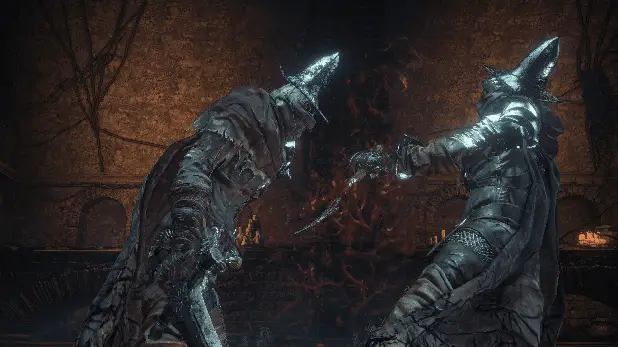
Their fall from grace is definitely one of the more interesting aspects of their lore but for me, the real interesting bit is the theme of legacy playing out. Artorias legacy is a complete story in its own right but so is theirs. Where Artorias is viewed as a beloved hero, the Abyss Watchers inspire more fear than anything. Their pointed helms and greatsword with curved dagger combo was a symbol so frightening that all it took was one look at them, and you knew your kingdom was doomed, funnily enough almost like the Abyss.
- Father Gascoigne and Old Hunter Henryk
“Beasts all over the shop…you’ll be one of them, sooner or later.”
- Father Gascoigne
Everybody loves a good duo. From Software is no exception, and neither are we. It is, after all, an exercise of jolly cooperation what you, dear reader, are seeing here. The prospect of close companionship between two individuals of skill and repute is quite catching. But sometimes, this gives way to some dark themes; be it discord that divides them, or a shared fate that unites them in tragedy. As you may guess, Bloodborne, a particularly dark entry in the franchise, explores the latter through the side story of Gascoigne and Henryk. Not only did they not survive the longest Hunt, virtually everyone around them met a ruinous end.
Father Gascoigne was an outsider to Yharnam. Like you, he came to the great city following the news of Blood Ministration, and the apparent wonders it worked. So he became a Hunter and a great addition to the Church’s ranks. During this time he struck a friendship with Henryk, a noted Hunter in the Church whose skill far exceeded his very old age. Gascoigne also found love with a woman, Viola, with whom he had two daughters. It’s worth noting there are slight hints that Henryk may be Viola’s father, so this friendship essentially became a family. All in all, things looked as bright for them as they could in a city built upon bloodshed. But the graces of Blood Ministration will only temporarily mask the horrors that will inevitably follow
The line between human and beast in this universe is treacherously thin. When the Hunt got the worst, Gascoigne kept his family locked at home for safety while he fought the Scourge. However, Viola tried catching up to him, suspecting the bloodlust would soon turn him into a beast. She was correct, but she perished before she could bring her husband back to his senses. We are now tasked with cutting him down. But the chain of misfortune doesn’t stop with his death. Henryk himself too goes mad with grief after the loss of his friend and (perhaps) his daughter. Though he doesn’t go beastly, it takes the joint effort of Eileen the Crow and you to take him down. Things get even darker if you consider he may have been waiting at Oedon cemetery for Gascoigne’s daughters, but they too were bound for an early grave regardless. The Old Blood spares nobody, not even the closest of friends or family.
- Slave Knight Gael
“What, still here? Hand it over. That thing, your dark soul. For my lady’s painting.”
- Slave Knight Gael
What can I say about Gael without completely overstating it and scaring all you readers away? Well for one he is probably one of the most well-written characters of the entire series and secondly, he was the absolute perfect way to send off the series. That is if Dark Souls 3 is the true finale. While at first glance, praying by the bonfire of the Cleansing Chapel, he doesn’t seem to be much more than an almost fanatical servant to his lady, The Painter. It is this small and slightly pathetic old man who would change the course of history forever, unhinging the cycles of fire and darkness. Explaining his lore completely would take an article in its own, as he features prominently in both of Dark Souls 3’s DLC. So I’ll keep this short and sweet.
Long story short, Gael is on a mission to help his Lady see fire in order to give her the drive and inspiration to repaint the painted world they live in, which is being consumed by rot. The rot itself being nurtured inadvertently by Sister Friede. In a similar cycle to that in the real world, it is possible that this painted world of Ariandel could have been once the painted world of Ariamis, but that’s a story for another day. While after defeating Friede and setting the chapel a blaze there is still one thing missing from The Painters needs, a pigment, one to create a new painting as none others have existed. Gael travels to the Ringed City to harness the power of the Furtive Pgymy’s Dark Soul.
Now most of the DLC is spent fighting the various defenses of the Ringed City. Alongside with what exactly they are guarding could also make an entry of their own concerning the very purpose of the Ringed City and Filianore herself. Concerning Gael however, it seems he put his trust in the Unkindled to not only unlock the secret that Filianore’s slumber kept but to also do what needed to be done when the time came… and oh did time come. While it is speculative whether cracking Filianores egg sent us forward into the far future or uncovered an illusion of the true Pygmy throne, the whole point is that it’s up to you what you believe. It’s here we find Gael, who succumbed to madness of time(obviously I believe the former) and the devouring of the souls of the Pygmy Kings. Knowing full well that having the Dark Soul within him would lead to his death as well as probably waiting that entire time for the Unkindled to end his life shows a strength of character that’s amazing to see properly done. By the end of it we’re all crying while the Painter is using the Dark Soul to create her new world, she never once forget the man that made it possible for her, “I wonder when Uncle Gael intends his return. I hope the new painting will be to him a gentle home.” I really hope it did.
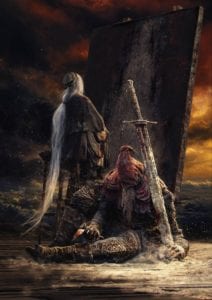
- The Tragedy of King Vendrick.
“What makes a king? Some say that it is birthright, while others call it destiny. Perhaps it is not important, as long as the king’s name serves to unite his people.”
- Kings Crown
I’m a sucker for Sophoclean tragedies, hence the inclusion of this one. There are two dominant themes driving the narrative in DSII: oblivion, and miscomprehension. While the former is the inevitable consequence of the passage of time between eras and kingdoms (as bitterly portrayed by the Lordvessel’s discarded remains in Majula), the latter is King Vendrick’s fatal error. After founding the Kingdom of Drangleic, the Flame lit by the Chosen Undead in Dark Souls begins to fade. And with that, the Undead Curse falls upon the land once again. To preserve the Kingdom, Vendrick and his brother Aldia began taking measures, guided by their faulty understanding of the curse.
They mistakenly see this as an infection that can be treated. What follows is a ruthless, misguided campaign of imprisonment and experimentation on Undead – all in search of a cure. Meanwhile, Vendrick’s Queen, Nashandra, also pushes him into waging war on the Giants. But it’s all in vain, for the Curse is linked to the fateful cycle of light and dark – life and death, to be repeated forevermore. The savagery, as a consequence, is all for nothing. Truth finally starts dawning on Vendrick, alas too late.
There is no cure against fate, not even Aldia’s experiments, resulting in the Ancient Dragon and our dear Shanalotte. And Nashandra, his Queen, is but a beautiful pretender – more on that later. Thus, Vendrick abandons his hubris in trying to escape fate, and instead surrenders to it. But not before denying his Queen the Throne of Want – a Kiln for the Flame to light anew. His final works are to leave plentiful obstacles (which we conquer) to keep Nashandra away from the Throne, and to leave his soul in the Shrine of Amana. Only his empty husk remains in the Undead Crypt, pathetically shambling about, while his intent, ignorance and realisation remain hidden mementos scattered across the land.
2. Knight Artorias, The Abyss Walker
“Thou must be the one who freed Artorias. An old friend he was, and thanks to thee…He left this world with honour intact.”
- Hawkeye Gough
As if you all didn’t know my main man Artorias wouldn’t helm the top two of this list, I mean honestly, who else could it be? Among all the dark and grimness that overwhelm the first Dark Souls (minus you sun-bro Solaire), Artorias offers a tale of self sacrifice, honor, and battle that lay on a scale so epic that our fight with him nearly eclipses any other the series has to offer. While his name is mentioned many times throughout the first game, we don’t actually get to witness the legendary warrior until the DLC and it is here we find a legacy based on lies. However, in this case not all lies are malicious.
The most important theme of his character of course would have to be legacy. However, to me the legacy left behind to his friends is far more impactful than his triumphs over the Darkwraiths or traversing the Abyss. The fact that he’s remembered so fondly by his friends and allies just speaks truth to his character. Hawkeye Gough, Sif, Ciaran, Alvina, and more show just how much this knight meant to them. Especially in how fiercely they fought to keep his legacy and honor alive, even if it was based on a lie. A lie that could help many to hold on to hope that there was some good in the world and that it had a champion.
However, as you trek through time to the human city of Oolacile via DLC, you will find yourself breaking through the mystique, and facing the terrible truth. When Manus, a native pygmy of the Ringed City died in Oolacile, his nature as an heir of the Dark Soul altered him, and all of Oolacile. This was the power of humanity unchecked, and the thing that Gwyn truly feared. And so, the Father of the Abyss was born, acting out of instinct rather than malice. Naturally, the King tasked Artorias with suppressing the rising Abyss, being better suited for it. But in the end, the Knight met defeat against Manus. Broken, he succumbed to the corruption of the Abyss. His final deed as himself was getting Sif out to safety.
The falsehood of his success in defeating Manus and rescuing the princess Dusk spread like wildfire. In truth, it was you, the Chosen Undead who fulfilled Artorias’ purpose. And in the process, you had to cut the Knight down, as he had become corrupted by the darkness. Some will likely find more than a few design and theme parallels between Artorias and Guts from Kentario Miura’s Berserk. The emotional response will probably mirror the same pairing. To contain the potential of the worst mankind had to offer, a Knight’s sacrifice was only half the measure – the other half was you, the best mankind had to offer. The resulting sum, the Legend of Artorias, shines a beacon with light of its own. Far from the Disparity that shapes the world, and the Age of Fire a King sent his Knight to die for.
- Lady Maria of the Astral Clocktower
“Good hunter. This may sound strange, but… have I somehow changed? Moments ago, from some place, perhaps deep within, I sensed a liberation from heavy shackles.”
- Plain Doll
The From Software formula is well-known, but there’s an aspect of it that should get as much recognition as the games’ difficulty. It’s the notion of a soothing, welcoming presence in an otherwise hostile and unforgiving world. These characters are on your side, and they’ll probably earn a place in your soul. But of all these, the Plain Doll stands out. Why? Cause her backstory is royally featured in Bloodborne’s The Old Hunters DLC, and it culminates in one of the greatest boss battles – I dare say – ever.
With even one glance at the Plain Doll’s make and demeanour, you can tell that she was made with love. Gehrman won’t reveal much himself. In fact, one infamous comment dismisses her as little more than an expendable thing. However, as soon as you step into the past via the Hunter’s Nightmare, you’ll learn of the bond between Gehrman and she who the Plain Doll takes after: Lady Maria of the Astral Clocktower. Once a scion of Cainhurst blood, she renounced their bloody ways and joined the Hunt.
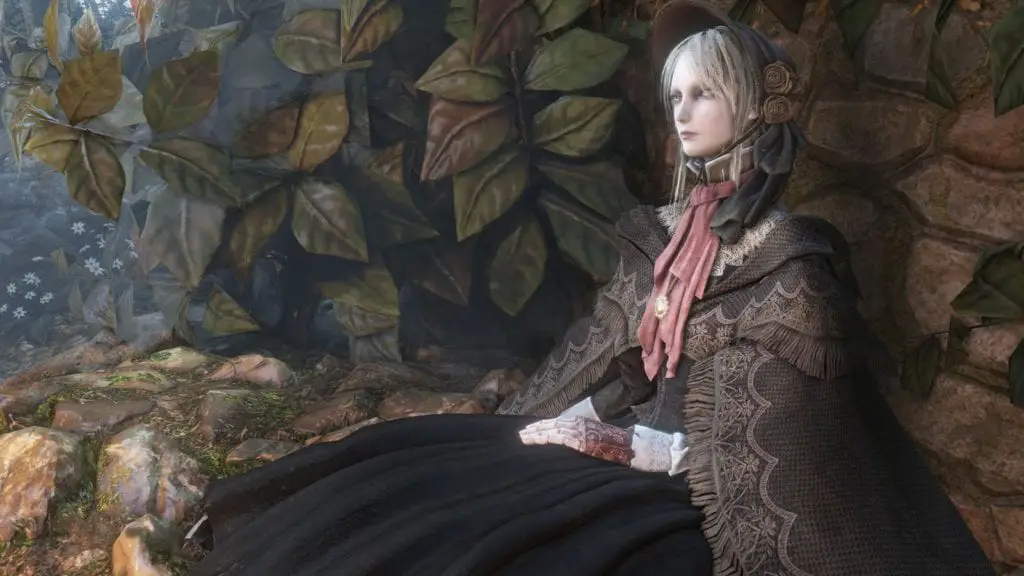
Once Maria answered the proud call of the group of Hunters led by Gherman, it seems that she built a powerful relationship with him. Whether it was romantic or not remains to be seen, but we can tell by various sources that he loved her fiercely. This was before the formal Healing Church militia was formed so we can assume there wasn’t too much in the way of procedure, they were more like mercenaries. At some point, they were hired by the Healing Church to discover a mysterious creature that washed up on the shore of an unnamed fishing village. The people who lived there were put under some kind of Lovecraftian spell as they came to worship this dying, and pregnant Great One. Yet, due to either the vanity of Laurence or the lust for “eyes on the inside” by Willem the creature was ordered to be killed so that its Umbilical cord within.
Midway through the DLC we finally discover the Clocktower and the horrors within. Couple this with what we’ve seen with Ludwig and Laurence we start to think to ourselves. Someone who is so respected and so savagely guarded must have had a bloodlust that was legendary. Yet, here’s where some of From Software philosophical genius comes in. Is it the act that sends you to this nightmare or is it the guilt? Is Maria here because of her part in killing a mother, eldritch horror or not or is she here because she is so disgusted and ashamed of herself for such a cruel act of wanton violence.
All the lore surrounding her points to the latter, for it is not her own life she guards but rather a secret of shame. Her actions speak louder than words as well in this case. Firstly that she departed with her beloved weapons, Rakuyo. Tossing them so thoughtlessly into a well because nothing will ever wash away the blood and guilt they are stained with. Second, in her actual boss fight, she becomes desperate enough to tap into the use of blood in her attacks. A staple of Cainhurst magic that she swore never to use again. In the end our own shame can make monsters of us all, and humans as well. As for Gherman, it seems not even he could bring back the real Maria.

